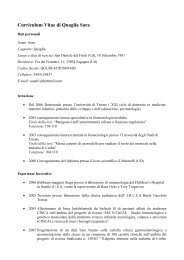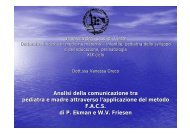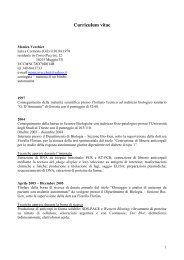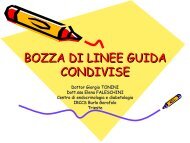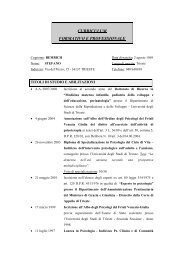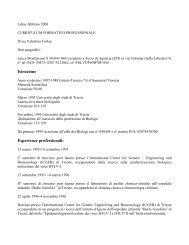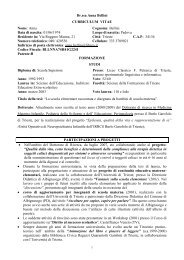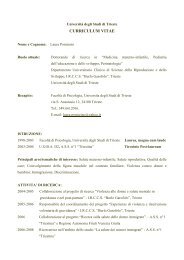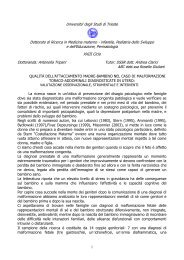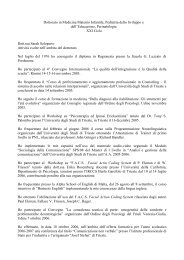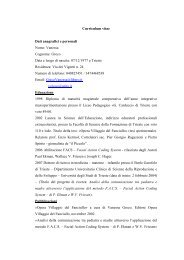universita - Clinica pediatrica - Università degli Studi di Trieste
universita - Clinica pediatrica - Università degli Studi di Trieste
universita - Clinica pediatrica - Università degli Studi di Trieste
You also want an ePaper? Increase the reach of your titles
YUMPU automatically turns print PDFs into web optimized ePapers that Google loves.
65 Van de Wal Y, Kooy Y, Van Veelen P, Vader W, Koning F, Pena S Coeliac <strong>di</strong>sease: it takes to three<br />
to tango!. Gut 46 (7): 734-737 ,2000<br />
66 Greco L, Romano R, Coto I et al The first large population based twin study of coeliac <strong>di</strong>sease. Gut<br />
50 (5): 624-628 ,2002<br />
67 King A L, Moo<strong>di</strong>e S J, Fraser J S, Curtis D, Reid E, Dearlove A M, Ellis H J, Ciclitira P J CTLA-<br />
4/CD28 gene region is associated with genetic susceptibility to coeliac <strong>di</strong>sease in UK families. J<br />
Med Genet 39 (1): 51-54 ,2002 68 Greco L, Babron M C, Corazza G R et al Existence of a genetic<br />
risk factor on chromosome 5q in Italian coeliac <strong>di</strong>sease families. Ann Hum Genet 65 (Pt1): 35-<br />
41,2001<br />
69 Clot F, Babron MC. Genetics of celiac <strong>di</strong>sease. Molec Genet Metabol 2000;71:76-80.<br />
70 Zhong F, McCombs CC, Olson JM, Elston RC, Stevens FM, McCarthy CF, Michalsky JP. An<br />
autosomal screen for genes that pre<strong>di</strong>spose to celiac <strong>di</strong>sease in the western countries of Ireland.<br />
Nat Genet 1996;14:329-333.<br />
71 Houlston RS, Tomlinson IP, Ford D, Seal S, Marossy AM, Ferguson A, Holmes GK, Hosie KB,<br />
Howdle PD, Jewell DP, Godkin A, Kerr GD, Kumar P, Logan RF, Love AH, Johnston S, Marsh MN,<br />
Mitton S, O’Donoghue D, Roberts A, Walker-Smith JA, Stratton MF. Linkage analysis of can<strong>di</strong>date<br />
regions for coeliac <strong>di</strong>sease genes. Hum Mol Genet 1997;6:1335-1339.<br />
72 Babron MC, Truy F, Eichenbaum-Voline S, Clerget-Darpoux F. Behavior of the maximum<br />
likelihood score when many affected sibpairs are issued from a few untyped patients. Genet<br />
Epidemiol 1997;14:518,A4.<br />
73 Greco L, Corazza GR, Clot F, Babron MC, Fulchignoni-Lataud MC, Percopo S, Zavattari P,<br />
Bouguerra F, Dib C, Tosi R, Troncone R, Ventura A, Mantovani W, Magazzù G, Gatti R, Lazzari R,<br />
Giunta A, Perri F, Iacono G, Car<strong>di</strong> E, De Virgiliis S, Cataldo F, De Angelis G, Musumeci S, Ferrari<br />
L, Balli F, Bardella MT, Volta U, Catassi C, Torre G, Eliaou JF, Serre JL, Clerget-Darpoux F.<br />
Genome search in coeliac <strong>di</strong>sease. Am J Hum Genet 1998;62:669-675.<br />
74 Djilali-Saiah I, Schmitz J, Harfouch-Hammoud E, Mougenot JF, Bach JF, Caillat-Zucman S. CTLA-4<br />
gene polymorphism is associated with pre<strong>di</strong>sposition to coeliac <strong>di</strong>sease. Gut 1998;43:187-189.<br />
75. Torinsson Naluai Å, Nilsson S, Samuelsson L, Gudjonsdottir AH, Ascher, Ek J, Hallberg B,<br />
Kristiansson B, Martinsson T, Nerman O, Sollid LM, Wahlström J. The CTLA4/CD28 gene region<br />
on chromosome 2q33 confers susceptibility to celiac <strong>di</strong>sease in a way possibly <strong>di</strong>stinct from that<br />
of type I <strong>di</strong>abetes and other chronic inflammatory <strong>di</strong>sorders. Tissue Antigens 2000;56:350-355.<br />
76. Holopainen P, Arvas M, Sistonen P, Mustalahti K, Collin P, Maki M, Partanen J. CD28/CTLA4 gene<br />
region on chromosome 2q33 confers genetic susceptibility to celiac <strong>di</strong>sease. A linkage and<br />
family-based association study. Tissue Antigens 1999;53:470-475.<br />
91




